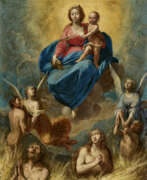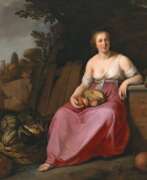History painting Karavagism


Gioacchino Assereto was a prominent Italian Baroque painter, celebrated for his dramatic and emotionally charged works that often depicted religious and historical subjects. Born in Genoa in 1600, Assereto's early career was marked by his apprenticeship with Luciano Borzone and Giovanni Andrea Ansaldo, which laid the foundation for his development as an artist. His paintings are known for their vibrant light effects and dynamic compositions, a style significantly influenced by Caravaggio during Assereto's brief visit to Rome in 1639. This influence is evident in his masterful use of chiaroscuro and sfumato techniques, which added depth and realism to his works.
Assereto's oeuvre includes powerful pieces like "The Lamentation," notable for its intense shadows and dramatic portrayal of Christ's body, and "The Torture of Prometheus," a work that showcases his later years' shift towards more emotional and theatrical compositions. His "Death of Cato" and "Ecce Homo" further illustrate this evolution, moving from refined styles to bold, expressive techniques that emphasize violent emotions through the dramatic effects of light.
Throughout his career, Assereto's works were highly regarded, with contemporary Genoese biographer Raffaele Soprani praising him as incomparable. His paintings can be found in significant collections, including the Musei di Strada Nuova in Genoa, the Cummer Museum of Art and Gardens, and the National Gallery in London. Assereto's legacy extends beyond his lifetime, with his son Giuseppe Assereto and others producing many copies of his work, ensuring the endurance of his artistic influence.
For art collectors and experts, Assereto's work embodies the Baroque spirit with its emotional intensity and technical mastery. His ability to convey deep psychological tension and his innovative use of lighting make his paintings a valuable study in the evolution of Baroque art.
If you're passionate about Baroque painting and interested in staying updated on sales and auction events related to Gioacchino Assereto's works, consider signing up for updates. This subscription will ensure you're informed about new opportunities to acquire pieces by this master of the Baroque period, enriching your collection with the depth and drama of Assereto's art.


Michelangelo Cerquozzi or Michelangelo delle Battaglie or Michelangelo delle Bambocciate was an Italian Baroque painter and member of the Accademia di San Luca in Rome.
The artist was a master of battle scenes and also painted in the Bambocciate style, hence his middle names. Cerquozzi , like many other painters of the time, was influenced by Caravaggio.


Antonio de Bellis was an Italian Baroque painter. Representative of the Neapolitan school of painting, caravagist.
Many pages from the life of the artist remained unknown. Antonio de Bellis worked in Naples in the second third of the 17th century. Along with Jose de Ribera, Massimo Stanzione, Bernardo Cavallini was one of the masters who worked in the style of caravaggism.


Jusepe de Ribera, a Spanish painter, etcher, and draughtsman, was a notable figure in the world of art, renowned for his distinct style and contribution to Castilian tenebrism. Born in 1591 in Játiva, near Valencia, Spain, Ribera's early life and artistic origins are somewhat shrouded in mystery, with no definitive documentation on his initial training. However, it's speculated that he might have started his artistic journey in Valencia.
Ribera's career took a significant turn when he moved to Italy, where he spent the majority of his professional life, predominantly in Naples, a Spanish territory at that time. He arrived in Naples around 1616 and soon established himself as an important artist in the city. His marriage to Caterina Azzolino, daughter of Sicilian painter Giovanni Bernardino Azzolino, in November of the same year, further solidified his connections in the Italian art scene.
Ribera was deeply influenced by Caravaggio and is often described as one of Caravaggio's followers. His early works displayed a marked tenebrism, characterized by stark chiaroscuro and a robust, scratchy handling of paint. However, Ribera's style evolved over time, moving away from this intense tenebrism to incorporate more color and softer modeling in his later works.
His body of work is diverse, including altarpieces, religious subjects, mythological themes, and portraits. Ribera had a penchant for depicting scenes of martyrdom with graphic realism, as seen in works like the celebrated "Martyrdom of St Bartholomew." Yet, he was also capable of expressing great tenderness, evident in paintings such as "The Adoration of the Shepherds." His secular subjects often depicted philosophers as beggars or vagabonds, adding a unique dimension to the Baroque repertoire.
Ribera's influence extended beyond Naples to Spain and the broader European art scene. He played a foundational role in fostering a respect for individual humanity in Spanish art, a trend that continued with artists like Velázquez and Goya. His works were widely exported to Spain and had a significant impact on both Italian and Spanish art. Ribera remains a highly respected figure in art history, and his works are featured in prominent museums and galleries worldwide, showcasing his enduring legacy in the realm of art and culture.
For art collectors and experts, Ribera's works represent a crucial chapter in the development of European art, particularly in the context of the Spanish Baroque and the evolution of tenebrism. His innovative approach to subject matter and technique continues to inspire and captivate audiences, making his works highly sought after in the world of art and antiques.
To stay updated on sales and auction events related to Jusepe de Ribera, sign up for our updates. This subscription service is tailored specifically for enthusiasts and experts in art and antiques, ensuring that you are the first to know about new opportunities to acquire works related to this influential artist.


Simon de Vos was a Flemish painter, graphic artist and art collector, a member of the Guild of St. Luke in Antwerp.
Simon de Vos specialized early in his career in cabinet and genre painting in the style of the Utrecht Caravagistes. His depictions of merry company and scenes from fables are well known. From about 1640 he increasingly painted large-scale religious, allegorical and historical scenes in the style of Peter Paul Rubens and Antoni van Dyck. Among his pupils was Jan van Kessel the Elder (1626-1679).
Simon de Vos was financially successful: by the end of his life he owned four estates in Antwerp and a collection of 290 paintings.


Johann Karl Loth was a German painter of the second half of the 17th century, the Baroque era. He is known as a painter and graphic artist, a representative of Caravaggism.
Loth painted canvases with historical, religious and mythological subjects, as well as portraits. In portrait painting, he brought elements of genre, which was influenced by the Flemish masters. The combination of dynamic brushstrokes, colorful variety and spectacular lighting in the style of the masters of Northern Italy attracted the attention of European collectors and aristocratic clients.


Mattia Preti was an Italian Baroque artist renowned for his dynamic and dramatic style, heavily influenced by Caravaggio. Born in Taverna, Calabria, in 1613, Preti's work spanned Italy and Malta, where he became a Knight of the Order of St. John and significantly contributed to the artistic landscape with his religious and mythological scenes. His career took him from Rome, where he was influenced by major painters of the early 17th century like Domenichino and Pietro da Cortona, to Naples and finally Malta, where he left an indelible mark on the St. John's Co-Cathedral through a series of paintings on the life and martyrdom of St. John the Baptist.
Preti's work is characterized by a rich Caravaggesque influence, noted for its vivid naturalism and dramatic use of light and shadow. However, his later works also display a blend of influences, including Neovenetian atmospheres and a reflection on Bolognese classicism, showcasing his versatility in adapting and synthesizing various stylistic elements of his time. Preti's paintings are celebrated for their emotional intensity and the ability to convey complex biblical and historical narratives with a profound sense of humanity and divine inspiration.
His paintings are held in prestigious museums worldwide, including the Louvre in Paris, the Museo del Prado in Madrid, and the National Museum of Fine Arts in Malta, featuring masterpieces such as "The Martyrdom of St. John the Baptist" and "The Death of Sophonisba". Preti's commitment to Caravaggesque vocabulary, even as he explored the influences of Veronese and possibly Rembrandt, showcases his unique position in the Baroque era, bridging the gap between Caravaggio's intense realism and the emerging Baroque idealism.
For collectors and experts in art and antiques, the legacy of Mattia Preti offers a fascinating study in the evolution of Baroque painting, reflecting the complex interplay of light, shadow, and color that defines the period. His works continue to inspire and captivate audiences, bearing testament to his skill and creative vision.
To stay informed about new discoveries, sales, and auction events related to Mattia Preti, consider signing up for updates. This service will keep you abreast of the latest opportunities to engage with Preti's enduring artistry, ensuring you're well-informed about developments related to this key figure in Baroque painting.


Dirk Jaspersz. van Baburen or Wijk bij Duurstede was a Dutch Golden Age painter, member of the Guild of Saint Luke of Utrecht. He is one of the leading representatives and creators of the Utrecht School of Caravaggio. Dirk van Baburen painted mainly on biblical and mythological subjects, as well as genre scenes with drunks and musicians.


Simon Vouet was a French painter who studied and rose to prominence in Italy before being summoned by Louis XIII to serve as Premier peintre du Roi in France. He and his studio of artists created religious and mythological paintings, portraits, frescoes, tapestries, and massive decorative schemes for the king and for wealthy patrons, including Richelieu. During this time, "Vouet was indisputably the leading artist in Paris," and was immensely influential in introducing the Italian Baroque style of painting to France. He was also "without doubt one of the outstanding seventeenth-century draughtsmen, equal to Annibale Carracci and Lanfranco."







